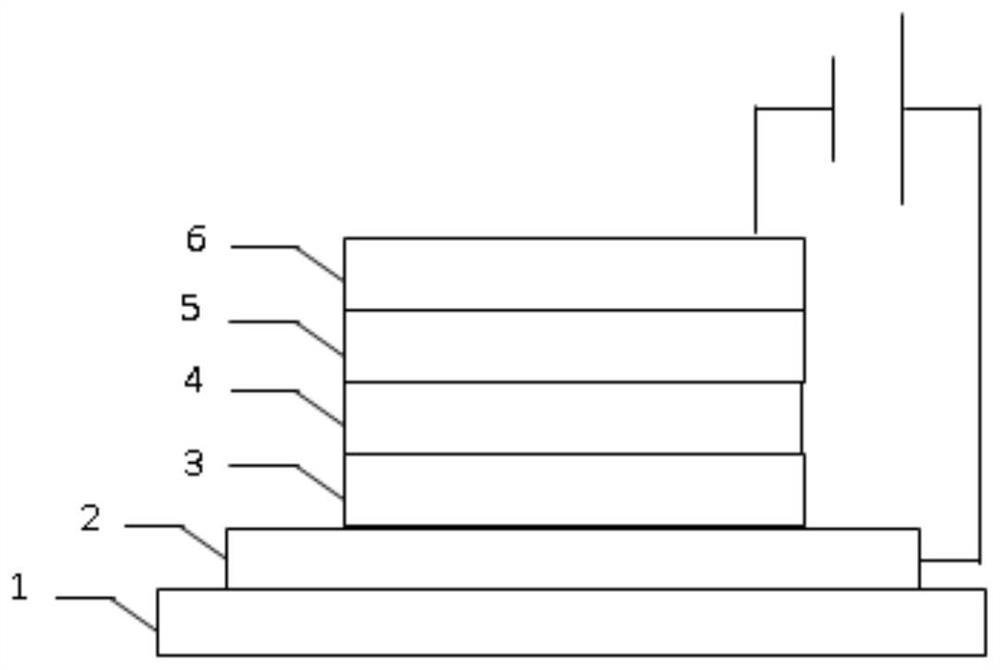Core-shell nanomaterial and its preparation method and quantum dot light-emitting diode
A core-shell nanomaterial, quantum dot luminescence technology, applied in nanotechnology, nanotechnology, nanotechnology for materials and surface science, etc., to achieve good stability, enhanced luminous efficiency, and improved electron and hole recombination efficiency. Effect
- Summary
- Abstract
- Description
- Claims
- Application Information
AI Technical Summary
Problems solved by technology
Method used
Image
Examples
preparation example Construction
[0020] On the other hand, the embodiment of the present invention also provides a method for preparing a core-shell nanomaterial, comprising the following steps:
[0021] S01: Provide ZnO nanoparticles and tin salt;
[0022] S02: dissolving the ZnO nanoparticles and tin salt in a solvent, and performing heat treatment under alkaline conditions to obtain a precursor solution;
[0023] S03: Annealing the precursor solution to obtain the core-shell nanomaterial.
[0024] In the preparation method of the core-shell nanomaterial provided by the embodiment of the present invention, ZnO nanoparticles and tin salt are dissolved in a solvent, and heat treatment is carried out under alkaline conditions to prepare a precursor solution, and then annealing treatment can obtain ZnO nanoparticles Core and SnO coated on the surface of the ZnO nanoparticle core 2 A core-shell material composed of a shell layer; the preparation method is a simple sol-gel method, which is simple and easy to im...
Embodiment 1
[0044] Taking the use of zinc acetate, tin sulfate, ethanol, potassium hydroxide, and ethyl acetate as examples, a detailed introduction will be made.
[0045] (1) First, add an appropriate amount of zinc acetate into 50ml of ethanol to form a solution with a total concentration of 0.2M-1M. Then stir and dissolve at 60°C, add potassium hydroxide dissolved in 10ml ethanol lye (molar ratio, OH - : Zn 2+ =(1.8-2.5):1, pH=12-13). Continue stirring at 60°C for 2h-4h to obtain a homogeneous transparent solution. Subsequently, after the solution was cooled, it was precipitated with ethyl acetate, and after centrifugation, it was dissolved with a small amount of ethanol (repeated operation, washing 3 times) to obtain ZnO nanoparticles.
[0046] (2) Add ZnO nanoparticles and an appropriate amount of tin sulfate to 30ml of ethanol to form a solution with a total concentration of 0.2M-1M, wherein the molar ratio of zinc: tin is 1: (0.05-0.1). Then stir and dissolve at 60°C, add potas...
Embodiment 2
[0049] Taking zinc nitrate, tin nitrate, methanol, ethanolamine, and heptane as examples, a detailed introduction is given.
[0050] (1) First, an appropriate amount of zinc nitrate is added to 50ml of methanol to form a solution with a total concentration of 0.2M-1M. Then stir and dissolve at 60°C, add ethanolamine dissolved in 10ml methanol lye (molar ratio, ethanolamine: Zn 2+ =(1.8-2.5):1, pH=12-13). Continue to stir at 60°C for 2h-4h to obtain a homogeneous transparent solution. Subsequently, after the solution is cooled, it is precipitated with heptane, and after centrifugation, it is dissolved with a small amount of methanol (repeat the operation and wash 3 times) to obtain ZnO nanoparticles.
[0051] (2) Add ZnO nanoparticles and an appropriate amount of tin nitrate to 30ml of methanol to form a solution with a total concentration of 0.2M-1M, wherein the molar ratio of zinc:tin is 1:(0.05-0.1). Then stir and dissolve at 60°C, add ethanolamine dissolved in 5ml methan...
PUM
 Login to View More
Login to View More Abstract
Description
Claims
Application Information
 Login to View More
Login to View More - R&D
- Intellectual Property
- Life Sciences
- Materials
- Tech Scout
- Unparalleled Data Quality
- Higher Quality Content
- 60% Fewer Hallucinations
Browse by: Latest US Patents, China's latest patents, Technical Efficacy Thesaurus, Application Domain, Technology Topic, Popular Technical Reports.
© 2025 PatSnap. All rights reserved.Legal|Privacy policy|Modern Slavery Act Transparency Statement|Sitemap|About US| Contact US: help@patsnap.com

